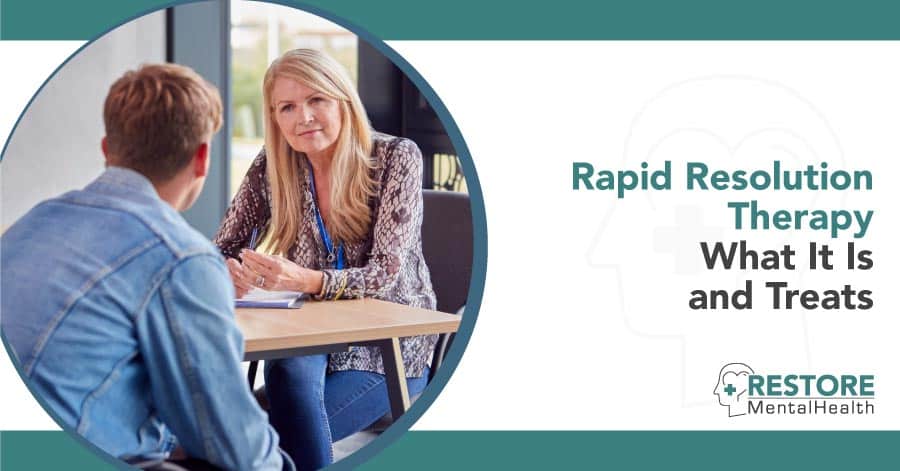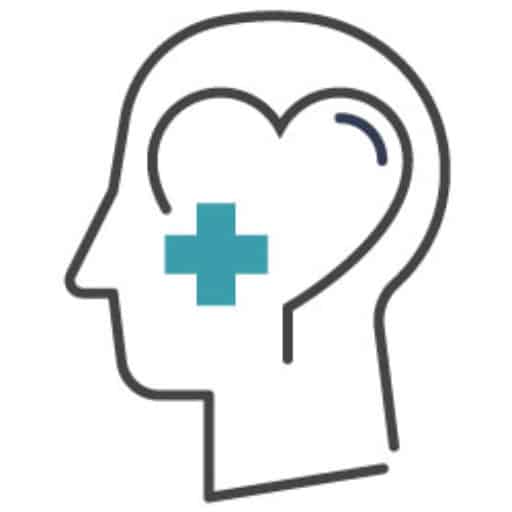To many people, the word ‘therapy’ brings to mind one-hour sessions where they talk to a therapist who just nods along and agrees with what they say. However, trauma comes in different forms, so addressing and treating it calls for different interventions. Rapid resolution therapy, or RRT therapy, is an alternative trauma intervention method that’s proved very effective in helping people quickly deal with traumatic events.
Read on to see what rapid therapy is, what it addresses, and what your RRT therapy sessions can look like once you start rapid trauma therapy at your nearest Restore center.
What Is Rapid Resolution Therapy?
Rapid trauma resolution is a non-traditional method of therapy originally developed to address trauma resulting from war, accidents or sexual violence. Today, rapid therapy can help you address most types of traumatic events, whether they only occurred once or multiple times.
Rapid therapy is talk therapy led by a certified RRT therapist. The therapist guides you as you recall the traumatic event and process the emotions it elicits. The end goal of rapid resolution therapy is to help rewire your neurological pathways so the trauma doesn’t have a continued hold on your life and behavior.
As the name suggests, RRT can help resolve your trauma in the shortest possible time.
What Is Trauma?
According to a study by Boston University, over 82% of Americans experience a traumatic event at least once in their lives. When you go through trauma, the brain records the mental and physical reactions that helped you survive the event.
Depending on the severity of the trauma, your brain may be unable to store experience as a memory. Instead, it remains on high alert to protect you from similar events in the future.
The traumatized brain releases high quantities of the stress hormone so you can quickly react whenever the situation demands it. Thus, the agitated state you were in during the traumatic experience becomes your permanent state of existence.
Someone living with trauma may experience many heightened emotions like stress and anger. They may also act irrationally, perceiving threats where there are none and withdrawing from the world to protect themselves.
What Is RRT Therapy Good at Treating?
While rapid trauma resolution therapy is a relatively new intervention, it’s proven effective in treating conditions like:
- Depression
- Anxiety disorders
- Insomnia
- Sexual assault
- Domestic violence
- Childhood abuse
- Substance abuse disorder
- Eating disorders
- Chronic pain
- PTSD
- OCD
Rapid resolution therapy is also effective in helping people address emotions like grief, anger, jealousy, shame and guilt.
What Is an RRT Therapy Session Like?
Many therapy interventions are client-led, whereby you drive the pace of each therapy session to achieve the desired outcome.
While working through trauma at your own pace can be effective, reliving the traumatic event as you talk it through with your therapist can be very triggering. And since you may need a long time to process and move on from the trauma, therapy can be a long-term process that takes a lot of your time and money.
Since RRT therapy is therapist-led, many people only require three to six sessions to develop a continued positive outlook on life.
First Session
The first session is known as the evaluation session. Your therapist will take about two hours to learn about you, asking questions to know your personal history before and after the traumatic event.
The evaluation session helps the therapist understand how the trauma affects your daily life. Together, you’ll identify the desired behaviors you need to exhibit to achieve normal functioning.
The content of the evaluation helps the therapist chart a path toward your long-term recovery.
Second Session
Your second RRT appointment is the core therapy session, which can take up to four hours.
During the session, the therapist will try to help you process the trauma and move to a mental space where you can live with the memory without experiencing adverse reactions.
First, you’ll go over the traumatic event. Instead of using ordinary language to talk about the traumatic experience, your therapist will help you use stories, metaphors, and images to refer to the trauma.
Using imagery soothes the reactive, emotional part of your brain so you can objectively evaluate the traumatic experience without experiencing severe emotional reactions.
Some therapists use hypnotic techniques to help your brain relax and calmly evaluate the experience. Hypnosis may also make your mind more receptive to the message your therapist communicates.
Afterward, your therapist will reinforce the idea that the traumatic event is an experience that happened in the past. They will also teach your subconscious how to react when triggered, helping you build better coping strategies for whenever your brain tries to take you back to a place where you’re scared and helpless.
Third Session
The third session is often the last one for rapid therapy. Your therapist can take up to 90 minutes to evaluate your progress and determine if the core session produced the desired results.
Veterans who undertook rapid therapy report experiencing a brain reset after the core session. They’re able to acknowledge the past traumatic experience and realize that it shouldn’t have a hold on their current lives. If the therapist determines that you’re already at this level of functioning, then your RRT intervention ends.
However, if the therapist notices that you still need more time to adjust your thoughts and actions, they can schedule further follow-up sessions to track your progress.
Why RRT Works
Therapy can rewire the brain from its trauma-induced high-alert setting to a position where you can calmly assess the world and regulate your emotions and actions. Trauma-informed therapy helps you process a traumatic event, identify your triggers and find ways to deal with them without resorting to fight-or-flight mode.
Rapid trauma resolution works because:
- It helps you explore the negative feelings attached to a traumatic experience without reliving the event.
- It helps your brain view and process things as they are rather than as they were.
- You can undertake RRT therapy alongside long-term interventions like dialectical behavior therapy and cognitive behavioral therapy.
At Restore, we’ve helped dozens of clients make positive life changes through different therapy interventions. Our services include both traditional and alternative therapy techniques. Call us today at (877) 594-3566 if you’re interested in RRT therapy and other forms of trauma intervention methods. Our experts are always available to help you achieve emotional freedom and create a meaningful life beyond trauma.



